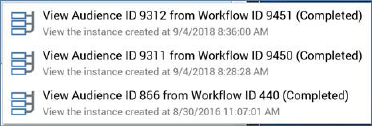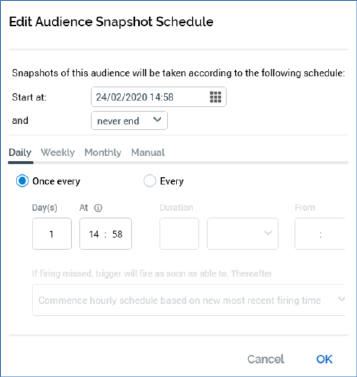
All audience snapshots defined within the Audience Snapshots configuration interface are displayed in the list.

If an audience snapshot is deleted in the configuration interface, it is no longer listed in the Operations tab. An advisory message is displayed if no audience snapshots have been configured.
For each audience snapshot, the following are displayed:
•Icon: a halo represents the status of the most recent instance of the audience snapshot that executed, and is shown in a tooltip on hover. Status may be one of the following:
o Never run (the initial state)
o Not started
o Play Requested
o Playing
o Completed
o Waiting for next trigger
o Failed
•[Name] updates [data warehouse table]
•Recurrence summary: displayed only for recurring audience snapshots. A verbal description of the snapshot’s recurrence settings is provided, e.g.:
‘Recurring trigger, starting at [date/time], running every week on [day] at [time]’
When outstanding changes exist within an audience snapshot, the recurrence summary (if shown) is replaced by a message:

•On Demand/Recurring: this toggle button is set to On Demand by default. It defines whether the audience snapshot is to be executed manually, or in accordance with a defined recurrence schedule. Having converted an audience snapshot to Recurring, when you save changes to the snapshot, execution commences in accordance with its recurrence schedule. Having converted an audience snapshot to On Demand, when you save changes, what happens next depends on the snapshot's current status:
o If Waiting for next trigger, its status set to Completed. No more audience instances will be created automatically and you must execute the snapshot manually.
o If Play Requested or Playing, the current instance completes, and the status' snapshot is then set to Completed.
•Actions menu: exposing the following:
o Open Previous Instance: this button gives access to an audience snapshot’s previous audience instances. If no instances exist, an advisory message is shown on invocation. If one or more audience instances exist, a list is displayed on invocation.

Selection of an instance displays it in the Audience Instance Viewer.
o Run Snapshot Now: this button is not available when outstanding changes exist within the audience snapshot, when its status is Play Requested or Playing, or when a recurring snapshot has Completed. Invocation is protected by an ‘Are You Sure?’ dialog, and an informational message advises that the audience snapshot has been scheduled to run. The snapshot’s status, in turn, is set to Play Requested, Playing then Completed.
Please see below for details of the data warehouse ramifications of the execution of audience snapshot.
o Edit Recurrence Schedule: this button is only shown if the snapshot is Recurring. Invocation displays the Edit Audience Snapshot Schedule dialog.

The dialog allows you to define the frequency at which the snapshot will be refreshed, and the number of instances that will be created. You can control:
§ The date and time at which the execution of the audience snapshot, and creation of audience instances, will begin.
§ Whether creation of audience instances will never end, will end when a given number of instances have been created, or will end by a given date and time.
§ Whether the audience snapshot will execute on a daily basis, and if so, once every [n] days at a given time, or every [n] minute(s) or hour(s) throughout the day for a given duration.
§ Whether the audience snapshot will execute on a weekly basis, and, if so, every [n] weeks at a given time on selected day(s) of the week.
§ Whether the audience snapshot will execute on a monthly basis, and, if so, on day [x] of every [y] months at a given time, or on the [nth] [day of the week] of every [x] months, also at a given time.
An orange message is displayed at the top of the list when unsaved changes exist within one or more audience snapshots therein.

If you attempt to close the Operations interface when unsaved changes are present, an ‘Are You Sure?’ dialog is displayed (note that, in this case, the interface is not closed if you elect to save changes).